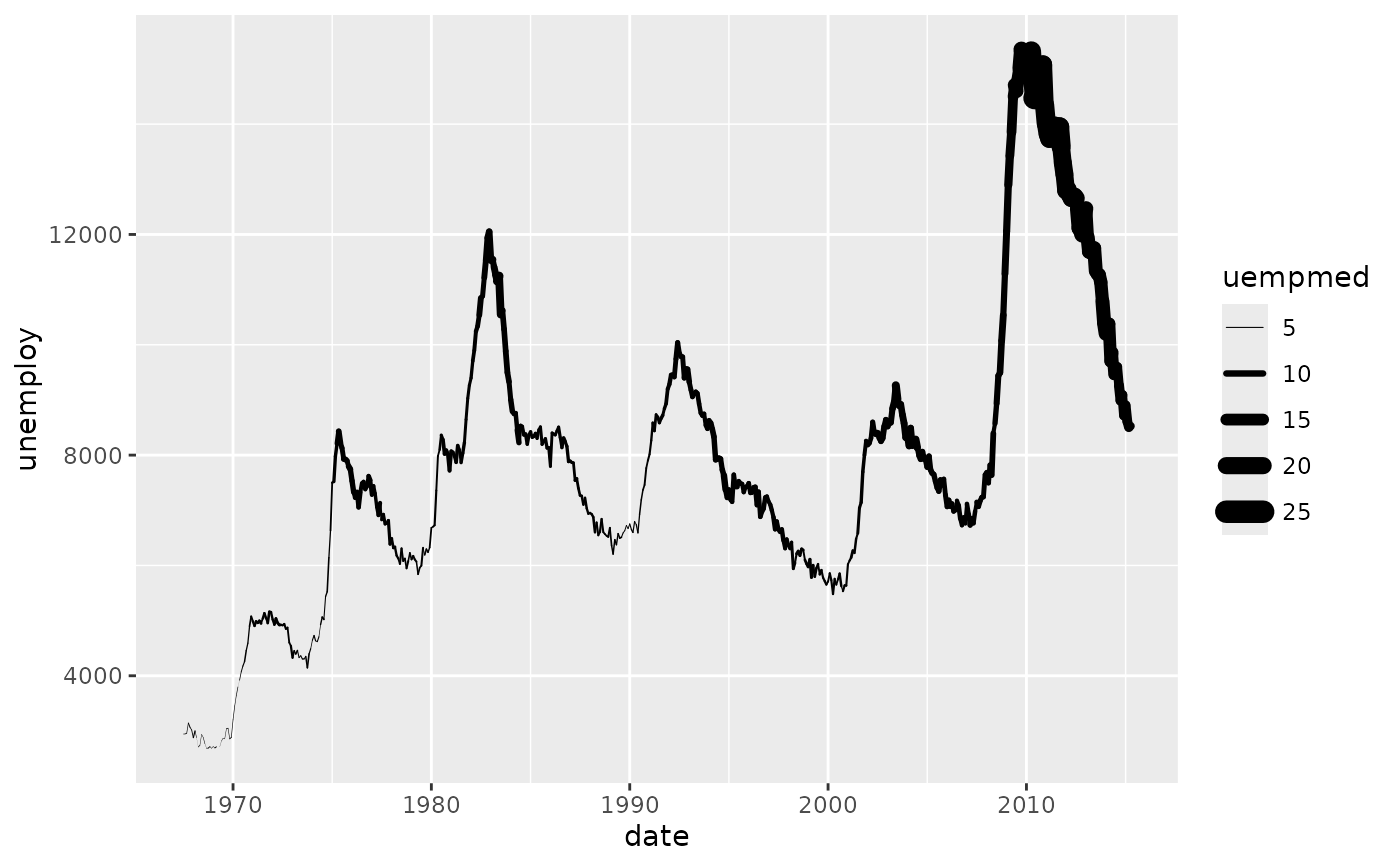scale_linewidth scales the width of lines and polygon strokes. Due to
historical reasons, it is also possible to control this with the size
aesthetic, but using linewidth is encouraged to clearly differentiate area
aesthetics from stroke width aesthetics.
Usage
scale_linewidth(
name = waiver(),
breaks = waiver(),
labels = waiver(),
limits = NULL,
range = NULL,
transform = "identity",
trans = deprecated(),
guide = "legend",
aesthetics = "linewidth"
)
scale_linewidth_binned(
name = waiver(),
breaks = waiver(),
labels = waiver(),
limits = NULL,
range = NULL,
n.breaks = NULL,
nice.breaks = TRUE,
transform = "identity",
trans = deprecated(),
guide = "bins",
aesthetics = "linewidth"
)Arguments
- name
The name of the scale. Used as the axis or legend title. If
waiver(), the default, the name of the scale is taken from the first mapping used for that aesthetic. IfNULL, the legend title will be omitted.- breaks
One of:
NULLfor no breakswaiver()for the default breaks computed by the transformation objectA numeric vector of positions
A function that takes the limits as input and returns breaks as output (e.g., a function returned by
scales::extended_breaks()). Note that for position scales, limits are provided after scale expansion. Also accepts rlang lambda function notation.
- labels
One of the options below. Please note that when
labelsis a vector, it is highly recommended to also set thebreaksargument as a vector to protect against unintended mismatches.NULLfor no labelswaiver()for the default labels computed by the transformation objectA character vector giving labels (must be same length as
breaks)An expression vector (must be the same length as breaks). See ?plotmath for details.
A function that takes the breaks as input and returns labels as output. Also accepts rlang lambda function notation.
- limits
One of:
NULLto use the default scale rangeA numeric vector of length two providing limits of the scale. Use
NAto refer to the existing minimum or maximumA function that accepts the existing (automatic) limits and returns new limits. Also accepts rlang lambda function notation. Note that setting limits on positional scales will remove data outside of the limits. If the purpose is to zoom, use the limit argument in the coordinate system (see
coord_cartesian()).
- range
a numeric vector of length 2 that specifies the minimum and maximum size of the plotting symbol after transformation.
- transform
For continuous scales, the name of a transformation object or the object itself. Built-in transformations include "asn", "atanh", "boxcox", "date", "exp", "hms", "identity", "log", "log10", "log1p", "log2", "logit", "modulus", "probability", "probit", "pseudo_log", "reciprocal", "reverse", "sqrt" and "time".
A transformation object bundles together a transform, its inverse, and methods for generating breaks and labels. Transformation objects are defined in the scales package, and are called
transform_<name>. If transformations require arguments, you can call them from the scales package, e.g.scales::transform_boxcox(p = 2). You can create your own transformation withscales::new_transform().- trans
- guide
A function used to create a guide or its name. See
guides()for more information.- aesthetics
The names of the aesthetics that this scale works with.
- n.breaks
An integer guiding the number of major breaks. The algorithm may choose a slightly different number to ensure nice break labels. Will only have an effect if
breaks = waiver(). UseNULLto use the default number of breaks given by the transformation.- nice.breaks
Logical. Should breaks be attempted placed at nice values instead of exactly evenly spaced between the limits. If
TRUE(default) the scale will ask the transformation object to create breaks, and this may result in a different number of breaks than requested. Ignored if breaks are given explicitly.
See also
The documentation for differentiation related aesthetics.
The line width section of the online ggplot2 book.




